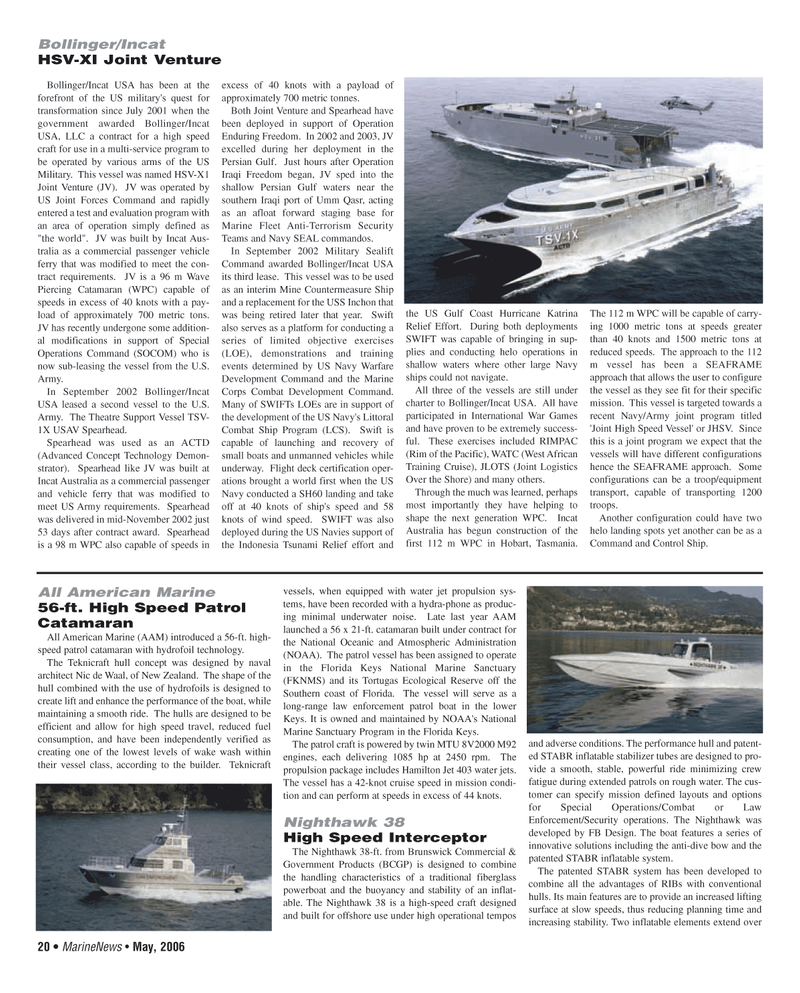
Page 20: of Marine News Magazine (May 2006)
The Combat Craft Annual
Read this page in Pdf, Flash or Html5 edition of May 2006 Marine News Magazine
All American Marine 56-ft. High Speed Patrol
Catamaran
All American Marine (AAM) introduced a 56-ft. high- speed patrol catamaran with hydrofoil technology.
The Teknicraft hull concept was designed by naval architect Nic de Waal, of New Zealand. The shape of the hull combined with the use of hydrofoils is designed to create lift and enhance the performance of the boat, while maintaining a smooth ride. The hulls are designed to be efficient and allow for high speed travel, reduced fuel consumption, and have been independently verified as creating one of the lowest levels of wake wash within their vessel class, according to the builder. Teknicraft vessels, when equipped with water jet propulsion sys- tems, have been recorded with a hydra-phone as produc- ing minimal underwater noise. Late last year AAM launched a 56 x 21-ft. catamaran built under contract for the National Oceanic and Atmospheric Administration (NOAA). The patrol vessel has been assigned to operate in the Florida Keys National Marine Sanctuary (FKNMS) and its Tortugas Ecological Reserve off the
Southern coast of Florida. The vessel will serve as a long-range law enforcement patrol boat in the lower
Keys. It is owned and maintained by NOAA's National
Marine Sanctuary Program in the Florida Keys.
The patrol craft is powered by twin MTU 8V2000 M92 engines, each delivering 1085 hp at 2450 rpm. The propulsion package includes Hamilton Jet 403 water jets.
The vessel has a 42-knot cruise speed in mission condi- tion and can perform at speeds in excess of 44 knots.
Nighthawk 38
High Speed Interceptor
The Nighthawk 38-ft. from Brunswick Commercial &
Government Products (BCGP) is designed to combine the handling characteristics of a traditional fiberglass powerboat and the buoyancy and stability of an inflat- able. The Nighthawk 38 is a high-speed craft designed and built for offshore use under high operational tempos and adverse conditions. The performance hull and patent- ed STABR inflatable stabilizer tubes are designed to pro- vide a smooth, stable, powerful ride minimizing crew fatigue during extended patrols on rough water. The cus- tomer can specify mission defined layouts and options for Special Operations/Combat or Law
Enforcement/Security operations. The Nighthawk was developed by FB Design. The boat features a series of innovative solutions including the anti-dive bow and the patented STABR inflatable system.
The patented STABR system has been developed to combine all the advantages of RIBs with conventional hulls. Its main features are to provide an increased lifting surface at slow speeds, thus reducing planning time and increasing stability. Two inflatable elements extend over 20 • MarineNews • May, 2006
Bollinger/Incat USA has been at the forefront of the US military's quest for transformation since July 2001 when the government awarded Bollinger/Incat
USA, LLC a contract for a high speed craft for use in a multi-service program to be operated by various arms of the US
Military. This vessel was named HSV-X1
Joint Venture (JV). JV was operated by
US Joint Forces Command and rapidly entered a test and evaluation program with an area of operation simply defined as "the world". JV was built by Incat Aus- tralia as a commercial passenger vehicle ferry that was modified to meet the con- tract requirements. JV is a 96 m Wave
Piercing Catamaran (WPC) capable of speeds in excess of 40 knots with a pay- load of approximately 700 metric tons.
JV has recently undergone some addition- al modifications in support of Special
Operations Command (SOCOM) who is now sub-leasing the vessel from the U.S.
Army.
In September 2002 Bollinger/Incat
USA leased a second vessel to the U.S.
Army. The Theatre Support Vessel TSV- 1X USAV Spearhead.
Spearhead was used as an ACTD (Advanced Concept Technology Demon- strator). Spearhead like JV was built at
Incat Australia as a commercial passenger and vehicle ferry that was modified to meet US Army requirements. Spearhead was delivered in mid-November 2002 just 53 days after contract award. Spearhead is a 98 m WPC also capable of speeds in excess of 40 knots with a payload of approximately 700 metric tonnes.
Both Joint Venture and Spearhead have been deployed in support of Operation
Enduring Freedom. In 2002 and 2003, JV excelled during her deployment in the
Persian Gulf. Just hours after Operation
Iraqi Freedom began, JV sped into the shallow Persian Gulf waters near the southern Iraqi port of Umm Qasr, acting as an afloat forward staging base for
Marine Fleet Anti-Terrorism Security
Teams and Navy SEAL commandos.
In September 2002 Military Sealift
Command awarded Bollinger/Incat USA its third lease. This vessel was to be used as an interim Mine Countermeasure Ship and a replacement for the USS Inchon that was being retired later that year. Swift also serves as a platform for conducting a series of limited objective exercises (LOE), demonstrations and training events determined by US Navy Warfare
Development Command and the Marine
Corps Combat Development Command.
Many of SWIFTs LOEs are in support of the development of the US Navy's Littoral
Combat Ship Program (LCS). Swift is capable of launching and recovery of small boats and unmanned vehicles while underway. Flight deck certification oper- ations brought a world first when the US
Navy conducted a SH60 landing and take off at 40 knots of ship's speed and 58 knots of wind speed. SWIFT was also deployed during the US Navies support of the Indonesia Tsunami Relief effort and the US Gulf Coast Hurricane Katrina
Relief Effort. During both deployments
SWIFT was capable of bringing in sup- plies and conducting helo operations in shallow waters where other large Navy ships could not navigate.
All three of the vessels are still under charter to Bollinger/Incat USA. All have participated in International War Games and have proven to be extremely success- ful. These exercises included RIMPAC (Rim of the Pacific), WATC (West African
Training Cruise), JLOTS (Joint Logistics
Over the Shore) and many others.
Through the much was learned, perhaps most importantly they have helping to shape the next generation WPC. Incat
Australia has begun construction of the first 112 m WPC in Hobart, Tasmania.
The 112 m WPC will be capable of carry- ing 1000 metric tons at speeds greater than 40 knots and 1500 metric tons at reduced speeds. The approach to the 112 m vessel has been a SEAFRAME approach that allows the user to configure the vessel as they see fit for their specific mission. This vessel is targeted towards a recent Navy/Army joint program titled 'Joint High Speed Vessel' or JHSV. Since this is a joint program we expect that the vessels will have different configurations hence the SEAFRAME approach. Some configurations can be a troop/equipment transport, capable of transporting 1200 troops.
Another configuration could have two helo landing spots yet another can be as a
Command and Control Ship.
Bollinger/Incat
HSV-XI Joint Venture
MAY MN2006 3(17-24).qxd 5/9/2006 9:55 AM Page 20

 19
19

 21
21
